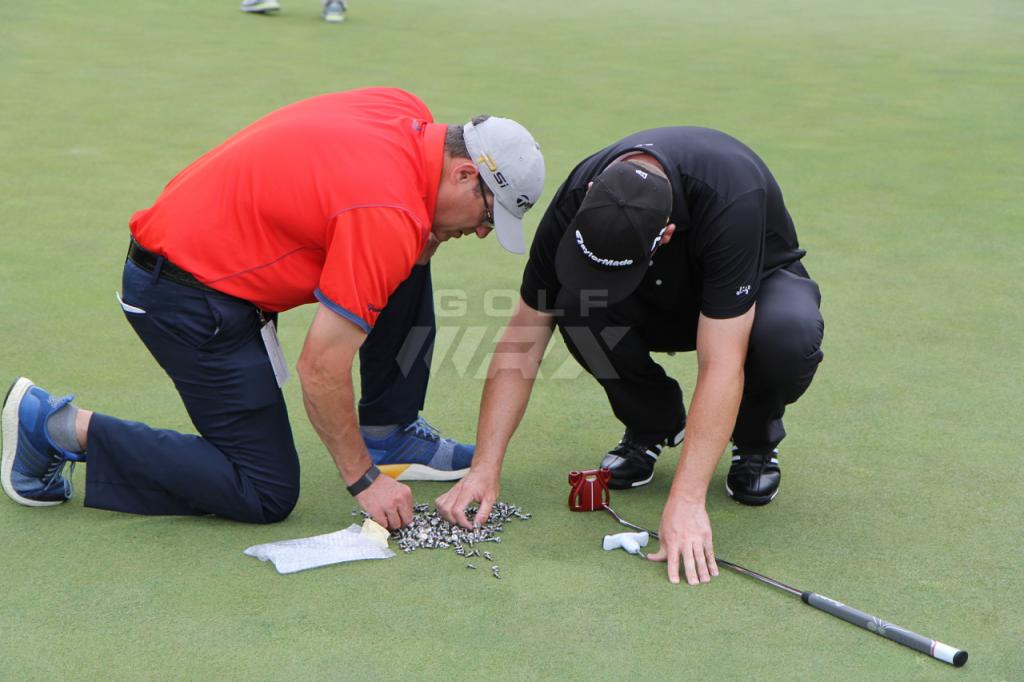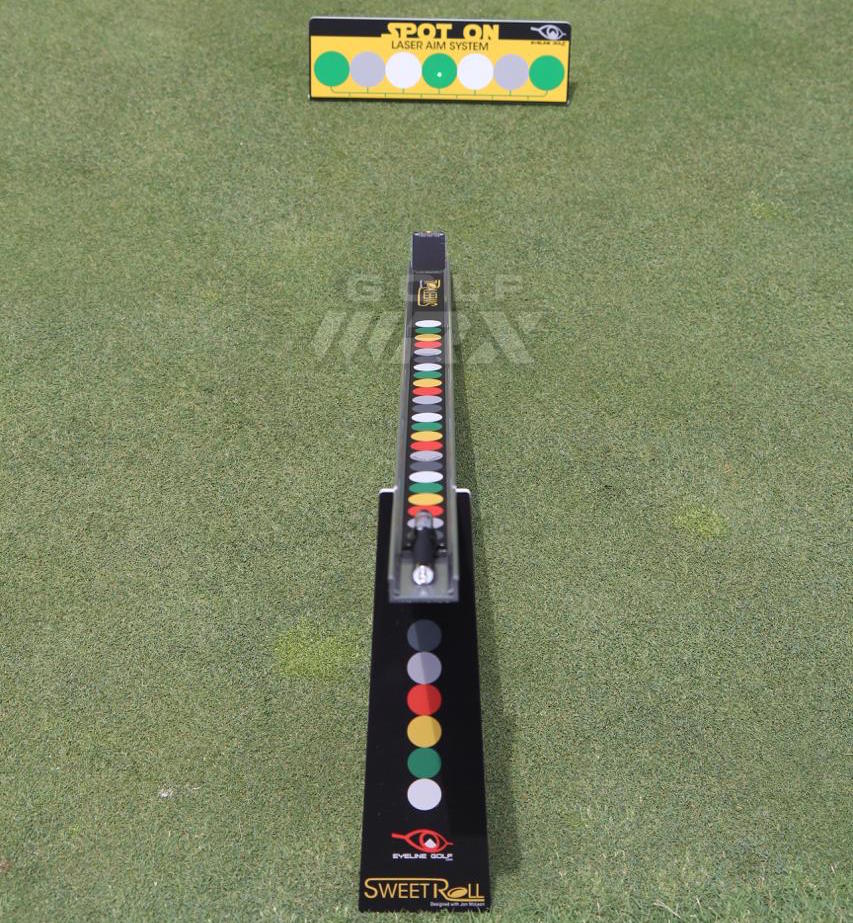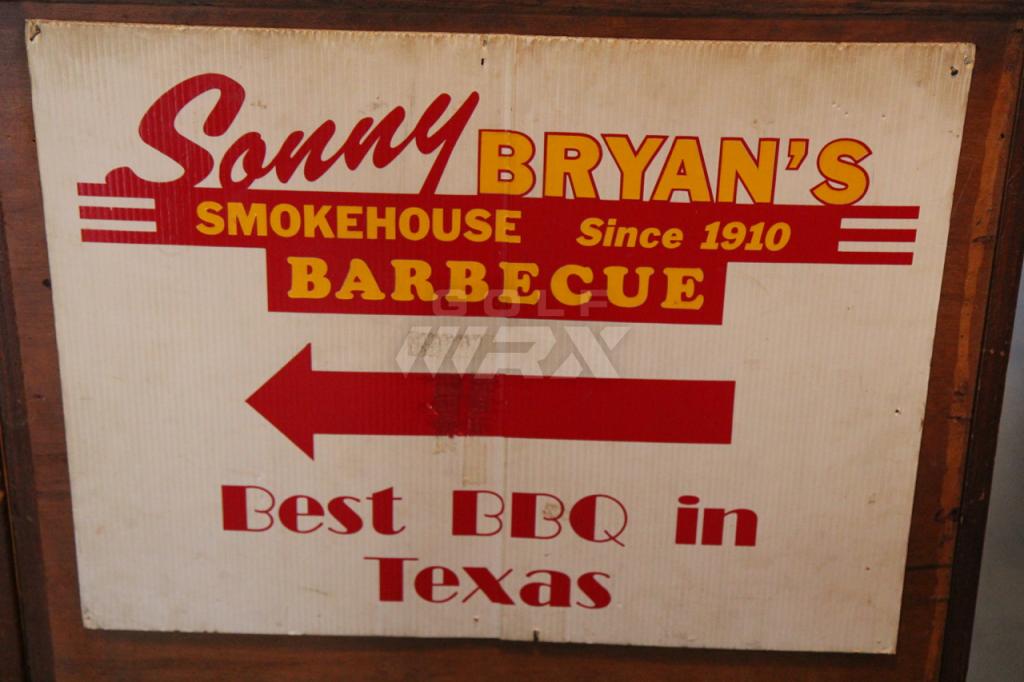Opinion & Analysis
9 Revealing photos from the 2016 AT&T Byron Nelson

GolfWRX was live this week from the 2016 AT&T Byron Nelson at the TPC Four Seasons Los Colinas in Dallas, Texas. If you missed any of the photos from this week, make sure to browse the galleries below.
This week, we celebrate one of the greatest golfers who ever lived, Byron Nelson, as well as the gift that is Texas BBQ. So before we dive into the revealing photos, break out the brisket and pour out some barbecue sauce for Lord Byron.
Ok, now, let’s reveal some photos from the Big D.
The Spider Limited Red putters hit the Tour
 And immediately send TaylorMade Tour reps into a frenzy trying to get them weighted properly for the players to test. But you’ll be hard pressed to convince me these don’t look sweet, even if you’re arachnophobic.
And immediately send TaylorMade Tour reps into a frenzy trying to get them weighted properly for the players to test. But you’ll be hard pressed to convince me these don’t look sweet, even if you’re arachnophobic.
Apparently Dustin Johnson agrees, since we spotted him testing one while on the SAM Putt Lab. He’s also been testing seemingly every putter on the market lately, including his Titleist Scotty Cameron, Edel “The Brick,” a Ping Anser style putter and a few other offerings from TaylorMade.
Surprisingly, with all of the struggles finding a reliable putter in 2016, D. Johnson is currently ranked 37th on Tour in Strokes Gained: Putting. But if he could ever find prolonged consistency on the greens…
Droppin the hammer inside the Tour Vans
Tour photographer Greg Moore always gives us WRXers an awesome look behind the scenes at Tour events, but it’s the glimpses inside the Tour vans that are always a favorite. In the photo above, he shows us a Callaway Rep chiseling away at a Mack Daddy 2 Tour Grind wedge.
Addressing wedge stampings
In recent years, wedge stampings have gone from a few funny movie quotes, or family members’ names, to a full-blown “thing.” And, as much as it pains me to say it, I just can’t give out props like participation medals anymore. So from now on, I’m being more strict on what makes the “revealing photos” cut when it comes to wedge stampings.
THAT being said, I will include anything that makes me think. For example, I thought the “Bradley Cooper called he wants his hair back” stamping from Darron Stiles was a movie quote. Turns out, Cooper may have actually called asking for his hair back.
Or the stamping just has to be something cool.
Welp. I guess this “something cool” wedge meets that priority. That big chalk mark on the toe, which I assume is a Tungsten plug or weight of some sort, is pretty cool, too.
Kuch is… one of us?
I didn’t realize Matt Kuchar was a sneaky GolfWRX member, but with a bag full of clubs representing 6 different OEMs, it’s never been more obvious. He even has a 64-degree Callaway Mack Daddy PM Grind in play this week.
Check out Kuchar’s full, updated 2016 WITB here.
Odyssey’s prototype has it all backwards
As Moore (aka Pga43) pointed out in this forum thread, this prototype from Odyssey, with the hosel in the toe instead of the heel, is reminiscent of “Jim Flood’s Basakwerd putter that Gene Littler putted with on tour briefly.”
Well, is it actually coming to retail anytime soon? Odyssey product designer Chris Koske took to the thread to clarify.
 We’ll see this week if anyone has this “Basakwerd” putter in play at the Byron Nelson.
We’ll see this week if anyone has this “Basakwerd” putter in play at the Byron Nelson.
Dr. Evil’s favorite training aid
The Sweet Roll and Spot On “Laser” Aim System.
Check out how the “Sweet Roll” works below.
Bryson DeChambeau’s Official One-Length Iron Playlist
A personal shoutout to the announcers on the weekly live coverage at PGA Tour events for pounding this fact into the ground, but DeChambeau plays single-length (still Edel, not Cobra), or one-length irons. He also listens to music, as you can tell from the photo above. Let’s take a guess at what his warm-up session playlist looks like, shall we?
- Back at One — Brian McKnight
- One Mic — Nas
- One — Metallica
- You’re Still the One – Shania Twain
- One (Is the loneliest number) — Three Dog Night
- One Way or Another — Blondie
- Wild One — Bobby Rydell
- One of These Days — Pink Floyd
- One In A Million – Aaliyah
- One — Creed
- You’re the One That I Want — John Travolta
- Only One — Yellowcard
- One More Chance — Jackson Five
- Let Me Be the One — Sapphire
- One Moment in Time — Whitney Houston
- One — U2
- Another One Bites the Dust — Queen
- One Shining Moment — Diana Ross
- One Love — Bob Marley & The Wailers
Also, a live look at Cobra reps waiting for Bryson to switch out of his Edel irons.
Matrix new shafts, inspired by Bruce Springsteen’s “Blinded By the Light”
Cut loose like a “Deus,” another runner in the night. Cue the theme song for Matrix’s new shaft.
Be on the lookout for tech info about the new shafts soon on our front page.
Finally, let’s eat some BBQ at the “Best BBQ in Texas”
Suuuure. Just like your local pizza joint is the “best” pizza in the world, right?
Actually, hold your doubts. The Original Sonny Bryan’s in Dallas won a James Beard Award — referred to as The Oscars of Food — in 2000, winning the “Americas Classics” award. So while many BBQ joints in Texas will call theirs the “best” in Texas, Sonny Bryan’s has a legitimate claim. Or at the very least, it has one of the longest-running BBQ traditions in Texas.
Opinion & Analysis
The 2 primary challenges golf equipment companies face

As the editor-in-chief of this website and an observer of the GolfWRX forums and other online golf equipment discourse for over a decade, I’m pretty well attuned to the grunts and grumbles of a significant portion of the golf equipment purchasing spectrum. And before you accuse me of lording above all in some digital ivory tower, I’d like to offer that I worked at golf courses (public and private) for years prior to picking up my pen, so I’m well-versed in the non-degenerate golf equipment consumers out there. I touched (green)grass (retail)!
Complaints about the ills of and related to the OEMs usually follow some version of: Product cycles are too short for real innovation, tour equipment isn’t the same as retail (which is largely not true, by the way), too much is invested in marketing and not enough in R&D, top staffer X hasn’t even put the new driver in play, so it’s obviously not superior to the previous generation, prices are too high, and on and on.
Without digging into the merits of any of these claims, which I believe are mostly red herrings, I’d like to bring into view of our rangefinder what I believe to be the two primary difficulties golf equipment companies face.
One: As Terry Koehler, back when he was the CEO of Ben Hogan, told me at the time of the Ft Worth irons launch, if you can’t regularly hit the golf ball in a coin-sized area in the middle of the face, there’s not a ton that iron technology can do for you. Now, this is less true now with respect to irons than when he said it, and is less and less true by degrees as the clubs get larger (utilities, fairways, hybrids, drivers), but there remains a great deal of golf equipment truth in that statement. Think about it — which is to say, in TL;DR fashion, get lessons from a qualified instructor who will teach you about the fundamentals of repeatable impact and how the golf swing works, not just offer band-aid fixes. If you can’t repeatably deliver the golf club to the golf ball in something resembling the manner it was designed for, how can you expect to be getting the most out of the club — put another way, the maximum value from your investment?
Similarly, game improvement equipment can only improve your game if you game it. In other words, get fit for the clubs you ought to be playing rather than filling the bag with the ones you wish you could hit or used to be able to hit. Of course, don’t do this if you don’t care about performance and just want to hit a forged blade while playing off an 18 handicap. That’s absolutely fine. There were plenty of members in clubs back in the day playing Hogan Apex or Mizuno MP-32 irons who had no business doing so from a ballstriking standpoint, but they enjoyed their look, feel, and complementary qualities to their Gatsby hats and cashmere sweaters. Do what brings you a measure of joy in this maddening game.
Now, the second issue. This is not a plea for non-conforming equipment; rather, it is a statement of fact. USGA/R&A limits on every facet of golf equipment are detrimental to golf equipment manufacturers. Sure, you know this, but do you think about it as it applies to almost every element of equipment? A 500cc driver would be inherently more forgiving than a 460cc, as one with a COR measurement in excess of 0.83. 50-inch shafts. Box grooves. And on and on.
Would fewer regulations be objectively bad for the game? Would this erode its soul? Fortunately, that’s beside the point of this exercise, which is merely to point out the facts. The fact, in this case, is that equipment restrictions and regulations are the slaughterbench of an abundance of innovation in the golf equipment space. Is this for the best? Well, now I’ve asked the question twice and might as well give a partial response, I guess my answer to that would be, “It depends on what type of golf you’re playing and who you’re playing it with.”
For my part, I don’t mind embarrassing myself with vintage blades and persimmons chasing after the quasi-spiritual elevation of a well-struck shot, but that’s just me. Plenty of folks don’t give a damn if their grooves are conforming. Plenty of folks think the folks in Liberty Corner ought to add a prison to the museum for such offences. And those are just a few of the considerations for the amateur game — which doesn’t get inside the gallery ropes of the pro game…
Different strokes in the game of golf, in my humble opinion.
Anyway, I believe equipment company engineers are genuinely trying to build better equipment year over year. The marketing departments are trying to find ways to make this equipment appeal to the broadest segment of the golf market possible. All of this against (1) the backdrop of — at least for now — firm product cycles. And golfers who, with their ~15 average handicap (men), for the most part, are not striping the golf ball like Tiger in his prime and seem to have less and less time year over year to practice and improve. (2) Regulations that massively restrict what they’re able to do…
That’s the landscape as I see it and the real headwinds for golf equipment companies. No doubt, there’s more I haven’t considered, but I think the previous is a better — and better faith — point of departure when formulating any serious commentary on the golf equipment world than some of the more cynical and conspiratorial takes I hear.
Agree? Disagree? Think I’m worthy of an Adam Hadwin-esque security guard tackle? Let me know in the comments.
@golfoncbs The infamous Adam Hadwin tackle ? #golf #fyp #canada #pgatour #adamhadwin ? Ghibli-style nostalgic waltz – MaSssuguMusic
Podcasts
Fore Love of Golf: Introducing a new club concept

Episode #16 brings us Cliff McKinney. Cliff is the founder of Old Charlie Golf Club, a new club, and concept, to be built in the Florida panhandle. The model is quite interesting and aims to make great, private golf more affordable. We hope you enjoy the show!
Opinion & Analysis
On Scottie Scheffler wondering ‘What’s the point of winning?’

Last week, I came across a reel from BBC Sport on Instagram featuring Scottie Scheffler speaking to the media ahead of The Open at Royal Portrush. In it, he shared that he often wonders what the point is of wanting to win tournaments so badly — especially when he knows, deep down, that it doesn’t lead to a truly fulfilling life.
View this post on Instagram
“Is it great to be able to win tournaments and to accomplish the things I have in the game of golf? Yeah, it brings tears to my eyes just to think about it because I’ve literally worked my entire life to be good at this sport,” Scheffler said. “To have that kind of sense of accomplishment, I think, is a pretty cool feeling. To get to live out your dreams is very special, but at the end of the day, I’m not out here to inspire the next generation of golfers. I’m not out here to inspire someone to be the best player in the world, because what’s the point?”
Ironically — or perhaps perfectly — he went on to win the claret jug.
That question — what’s the point of winning? — cuts straight to the heart of the human journey.
As someone who’s spent over two decades in the trenches of professional golf, and in deep study of the mental, emotional, and spiritual dimensions of the game, I see Scottie’s inner conflict as a sign of soul evolution in motion.
I came to golf late. I wasn’t a junior standout or college All-American. At 27, I left a steady corporate job to see if I could be on the PGA Tour starting as a 14-handicap, average-length hitter. Over the years, my journey has been defined less by trophies and more by the relentless effort to navigate the deeply inequitable and gated system of professional golf — an effort that ultimately turned inward and helped me evolve as both a golfer and a person.
One perspective that helped me make sense of this inner dissonance around competition and our culture’s tendency to overvalue winning is the idea of soul evolution.
The University of Virginia’s Division of Perceptual Studies has done extensive research on reincarnation, and Netflix’s Surviving Death (Episode 6) explores the topic, too. Whether you take it literally or metaphorically, the idea that we’re on a long arc of growth — from beginner to sage elder — offers a profound perspective.
If you accept the premise literally, then terms like “young soul” and “old soul” start to hold meaning. However, even if we set the word “soul” aside, it’s easy to see that different levels of life experience produce different worldviews.
Newer souls — or people in earlier stages of their development — may be curious and kind but still lack discernment or depth. There is a naivety, and they don’t yet question as deeply, tending to see things in black and white, partly because certainty feels safer than confronting the unknown.
As we gain more experience, we begin to experiment. We test limits. We chase extreme external goals — sometimes at the expense of health, relationships, or inner peace — still operating from hunger, ambition, and the fragility of the ego.
It’s a necessary stage, but often a turbulent and unfulfilling one.
David Duval fell off the map after reaching World No. 1. Bubba Watson had his own “Is this it?” moment with his caddie, Ted Scott, after winning the Masters.
In Aaron Rodgers: Enigma, reflecting on his 2011 Super Bowl win, Rodgers said:
“Now I’ve accomplished the only thing that I really, really wanted to do in my life. Now what? I was like, ‘Did I aim at the wrong thing? Did I spend too much time thinking about stuff that ultimately doesn’t give you true happiness?’”
Jim Carrey once said, “I think everybody should get rich and famous and do everything they ever dreamed of so they can see that it’s not the answer.”
Eventually, though, something shifts.
We begin to see in shades of gray. Winning, dominating, accumulating—these pursuits lose their shine. The rewards feel more fleeting. Living in a constant state of fight-or-flight makes us feel alive, yes, but not happy and joyful.
Compassion begins to replace ambition. Love, presence, and gratitude become more fulfilling than status, profits, or trophies. We crave balance over burnout. Collaboration over competition. Meaning over metrics.
Interestingly, if we zoom out, we can apply this same model to nations and cultures. Countries, like people, have a collective “soul stage” made up of the individuals within them.
Take the United States, for example. I’d place it as a mid-level soul: highly competitive and deeply driven, but still learning emotional maturity. Still uncomfortable with nuance. Still believing that more is always better. Despite its global wins, the U.S. currently ranks just 23rd in happiness (as of 2025). You might liken it to a gifted teenager—bold, eager, and ambitious, but angsty and still figuring out how to live well and in balance. As much as a parent wants to protect their child, sometimes the child has to make their own mistakes to truly grow.
So when Scottie Scheffler wonders what the point of winning is, I don’t see someone losing strength.
I see someone evolving.
He’s beginning to look beyond the leaderboard. Beyond metrics of success that carry a lower vibration. And yet, in a poetic twist, Scheffler did go on to win The Open. But that only reinforces the point: even at the pinnacle, the question remains. And if more of us in the golf and sports world — and in U.S. culture at large — started asking similar questions, we might discover that the more meaningful trophy isn’t about accumulating or beating others at all costs.
It’s about awakening and evolving to something more than winning could ever promise.

























Kevin
May 22, 2016 at 9:21 am
Was going to say, I live in Dallas and let’s be serious. Sonny Bryan’s is not even top 5. Pecan Lodge hands down.
Mark reed
May 21, 2016 at 6:04 pm
Revved up,was manfred Mann, not Springsteen
RacerX
May 25, 2016 at 12:26 pm
Springsteen wrote that song for Manfred Man.
Todd
May 21, 2016 at 2:15 pm
Sonny Bryan’s is a joke. You clearly didn’t ask any locals where to go for good BBQ. If you’re still there go to either Pecan Lodge in Deep Ellum or Hard Eight in Coppell.